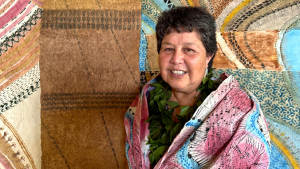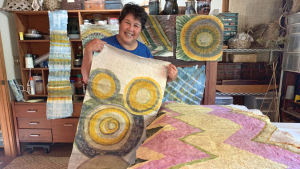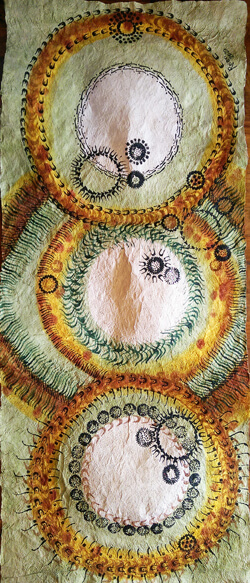
You could say that reclaiming elements of Native Hawaiian artistry that were nearly lost and forgotten is interwoven into Roen Kahalewai Hufford’s DNA. The University of Hawaiʻi at Mānoa alumna is the leading figure in the traditional art of ka hana kapa (making barkcloth) and this fall, received one of the nation’s highest honors in the folk and traditional arts from the National Endowment for the Arts (NEA) for her leadership in the revival of kapa.
- Related UH News story: Reclaiming the art of kapa earns UH Mānoa alumna national art fellowship, March 10, 2023

NEA recognized her as a 2023 National Heritage Fellow at the agency’s public ceremony in Washington, D.C. in September. Hufford firmly follows in the footsteps of her mother, expert Kanaka ʻŌiwi (Native Hawaiian) artisan Marie Leilehua McDonald known for her mastery and scholarship in the art of lei-making. McDonald, who died in 2019, was also named a NEA National Heritage Fellow in 1990.
“I was overwhelmed and I cried because my mother was not here to know that I had done this or that somebody even thought to honor me,” Hufford said. “We just go about our lives doing what needs to be done. I like to think of all the kapa makers in my generation who knew my mother, who were inspired by her. I would hope that they share in this with me because we are all colleagues in our different projects.”
From the ground up

For the last 30 years, interest in ka hana kapa has grown with Hufford at the helm. The kapa making process is long and labor intensive. It begins with peeling and cleaning the bast (fibrous material) from 7- to 10-foot stems cut from wauke (paper mulberry) trees. The fiber is soaked in sea water, beaten with wooden mallets into thin sheets, and then felted into larger pieces. In Hawaiʻi, delicate watermarks are imprinted by patterned beaters and the dried kapa is decorated with natural colors derived from flowers, fruits, bark and soil. Dyes are applied with handmade stamps, brushes, bits of wood and even leaf stems.
The renowned kapa artist called Kāneʻohe home as a child before her ʻohana (family) relocated to a 9-acre farm on Hawaiian Homelands in Waimea on Hawaiʻi Island. Hufford credits her mom for raising them to trust their artistic expression, a skillset she tries to pass down to her own ka hana kapa haumāna (students).
“I don’t ever recall her saying that we had made a mistake. She never said to us, ‘No, that’s not the way.’ She accepted every attempt and encouraged us to self-evaluate. She was exemplary as a teacher in that she saw potential in all of her students,” Hufford explained.
Inspirational impacts

From 1970–73, Hufford attended UH Mānoa and earned a bachelor’s degree in art. While studying at the university, Hufford relished the opportunity to soak in the campus’ wide spectrum of courses ranging from music to botany.
“I found it really exciting to take something outside of my major and understand how important plants are to us in the whole scheme of life, so that really impacted me,” Hufford said.
Even today, cultivating and making kapa are inseparable for her. She still resides on her family’s farm in Waimea which is surrounded by hundreds of wauke trees that flourished from three tiny cuttings that were first planted by her mother. Hufford hosts a weekly kapa hui (kapa group) at the farm where students of all ages, backgrounds and skill levels come to learn and share with each other.
On display
This October, the Department of Hawaiian Homelands (DHHL) installed Hufford’s “Lei Hulu” piece inside its headquarters in Kapolei. The Hawaiʻi State Foundation on Culture and the Arts has six kapa pieces made by Hufford on display in the Art in Public Places Collection. Three pieces (“Alaea,” “Ka Papa Honua (strata of earth)” and “Piʻi Ka Mauna”) are also on display at Capitol Modern (formerly the Hawaiʻi State Art Museum) through the end of this year. Admission is free.
The UH Mānoa Department of Art and Art History is housed in the College of Arts, Languages and Letters.

